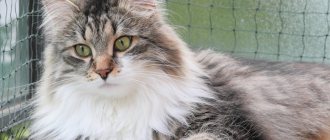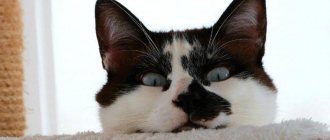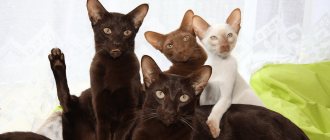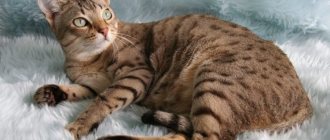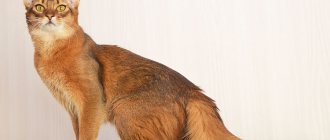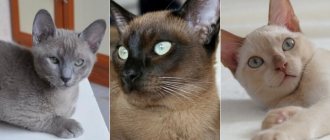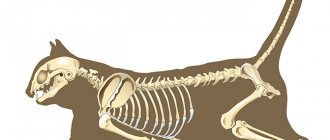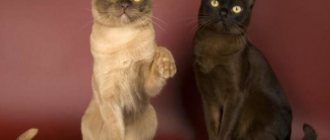What is a tail
The cat's tail is an extension of the spine and makes up about 10% of its total length. It consists of vertebrae, muscle tissue and skin. The mobility and maneuverability of the limb is ensured by the musculoskeletal structure with ligaments and tendons. The tail has its own peculiarity: it originates from a single bone formed by fused vertebrae of the sacral region.
It's hard to imagine a cat without a tail
Structural features
Depending on the breed, the tail reaches a length of about 25 cm in females and 28 cm in males. It may consist of 19-23 vertebrae. At the base the vertebrae are short and wide, and towards the end of the tail they gradually narrow and lengthen.
Why do cats need whiskers: main functions and what they are called scientifically
The first 8 vertebrae resemble an arch. The vertebrae at the tip do not have a spinal canal. The last vertebra is small in diameter and length. It differs from all others in its asymmetry and sharpness. In some animals, the last caudal vertebra may be underdeveloped or vestigial. Between the vertebrae there are very plastic intervertebral discs.
The cat's tail is conventionally divided into three parts:
- Root. It originates from the sacrum and consists of 4-6 fused vertebrae.
- Stem. The main part of the limb, elongated, consists of 10-15 vertebrae.
- Tip. The vertebrae are thinner and shorter towards the end.
The strength of the tail is due to the presence of ligaments. Three long tail muscles and a short one provide mobility of the tail.
Additional Information! Females have a shorter tail than males.
Skeleton structure of a cat
Understanding your pet
At first glance, it seems that the cat’s tail has a life of its own. But observing its movements can help owners understand what the animal wants.
What is the significance of a cat’s tail, and how does a pet express emotions:
- if the cat lowers it and does not move it, then the animal is tired or disappointed in something;
- raised up and moving the tip means joy;
- if a cat raises its tail up, then it feels superiority, dominance;
- when a cat lifts its tail up, it shows its pride;
- if the pet makes smooth movements with it, similar to a snake’s, then it shows interest;
- if the animal cannot choose something or is in thought, then the tail makes waving movements from side to side with a small amplitude;
- when a cat shows aggression, the movements of the tail show his confidence - it stands on end and his ears are flattened;
- if the cat is in a good mood and is happy to see the owner, then he runs up, begins to rub against his legs, and lifts his tail up;
- if the fur is very bristling, this means that the animal is excited (confrontation with relatives or an angry mood);
- if the pet makes movements from side to side with a large amplitude, then this shows his sexual attraction;
- beating the tail on the floor means anger on the part of the pet, this is how he expresses his dissatisfaction, while the eyes may be closed or look continuously at one point.
It is interesting that tailless animals are very limited emotionally. They cannot correctly show their feelings, mood, desires. The importance of a tail for a cat can be compared to the importance of fingers for a person who speaks sign language.
Basic physiological functions
Anyone who cannot understand why a cat needs a tail should remember that it performs important physiological functions for the animal. With its help, the cat communicates with the outside world, expresses its emotions and protects itself from enemies. It makes navigation easier, improves hunting performance and reduces the risk of injury to the cat.
Thermoregulation
What smells do cats not like: what are they afraid of and what scares them away?
The tail is an excellent regulator of the animal’s body temperature. In hot weather, the cat uses it as a fan. With its help, it creates a breeze and cools down. And when it’s cool, it warms itself by curling up in a ball and covering itself with its tail like a blanket.
Balancing agent
One of the main purposes of a cat's tail is for balancing. It, like a person’s hand, helps to maintain balance. Animals climb tall trees, balconies and often fall from heights. Thanks to their tail, they are able to maneuver in the air and land on 4 paws. This minimizes the risk of injury.
Interesting! Even having fallen from a great height, above the 6th floor, a cat can get away with just a slight fright.
Successfully balancing with the help of its tail, the animal can easily walk along thin branches and narrow cornices.
Fun and comfort
When answering the question of why a cat needs a tail, it is important to understand that the organ serves to create its own comfortable microclimate. During periods of extreme heat, the animal waves them, which allows for additional cooling of the body. And in the cold season, the cat curls up into a ball and hides its nose under its tail.
If the pet gets bored, then this organ turns into an interesting toy. The cat hunts for him and catches him like real prey. It is especially interesting to watch small kittens who often play with their tail.
Despite the importance of the organ for a cat, this part of the body is considered inviolable. Rarely do animals allow him to be petted, combed or washed.
What do tail movements mean?
Why does a dog chew its tail until it bleeds: what to do
The cat is a sociable and very emotional animal. He, like a small child, is very open and does not hide his feelings, mood and attitude towards certain situations. Cat language is quite difficult for humans to understand. But he can easily determine what mood his pet is in by the movement of his tail. Reading tail position values is a science.
Important! By learning to understand what a certain tail position may mean, the owner will be able to build a harmonious relationship with the pet.
Tail as a means of communication
For cats, their furry limb is an effective tool for meaningful communication. The position of the tail in relation to the body of 45 degrees indicates that the pet is trying to assess the situation, doubts, and something is bothering him. In this case, the owner should expect both pleasant and unpleasant surprises: a purring lump on his lap or scratched furniture.
Misunderstood situations (shot, clap) cause fear. In this case, the reaction will be immediate, and the animal will tuck its tail. Often he is not only tense, but also staggers. Curious and active cats regularly get into trouble, so the owner is very familiar with this state of the cat.
When an animal is irritated, it nervously beats its tail. The cat turned his back and raised his tail - he completely trusts and respects the person.
Intimidating enemies
A fluffy, raised tail is a defensive reaction. In this way he tries to look intimidating and intimidate his offender. Many animals use such tactics for self-defense and to avoid clashes with enemies.
Tail guard position
Comfort and fun
If the tail is erect, then the pet is in a good-natured and good mood. He is happy with everything and everything suits him. This usually happens when the animal meets the owner and fawns over him. In this way it tries to attract attention and get affection.
When an animal is in a playful mood, its tail is raised up and slowly sways from side to side. But at such a moment it is better not to touch the young cat, because he may not like it.
A raised tail with a curved tip indicates that the cat is in a good-natured mood, but prefers to be alone. When positioned parallel to the floor, the cat is friendly.
The cat plays with his tail
For these pets, their furry limb provides entertainment and exercise. He reminds his owner of a potential victim, because he is always on the move. But over time, the game becomes uninteresting to them, and the research process does not last long. They quickly realize that it is part of their body and not a target.
Additional Information! You should not stop your kitten from playing with his tail, because he will never harm himself, so there is no need to worry.
Hunting for prey
If a limb knocks on the floor, this is a manifestation of the hunting instinct. When a cat behaves this way, you can understand that he is watching his prey and is about to make a jump towards his target (toy, mouse, plant or insect). They can remain in a waiting position for a long time and wait for the right time to attack the animal.
Long-tailed cat breeds
Abyssinians have a considerable size of this appendage.
The length of the appendage at the rear end of the body in different cats depends on the breed. The Maine Coon cat Cygnus Regulus Powers from the USA is listed in the Guinness Book of Records. It has the longest tail in the world with a length of 44.66 cm. Cats have sizes of this organ ranging from 25 to 35 cm. The list of animals with long tails includes:
- Abyssinian;
- Australian smoky;
- Asian tabby;
- American Curl;
- Angora;
- Balinese;
- Bengali;
- Brazilian Shorthair;
- Dragon Li;
- California radiant;
- ringtail;
- laperm;
- Neva Masquerade;
- Persian;
- Russian blue;
- Nibelung;
- Norwegian forest;
- Don Sphynx;
- rexes (Oregon, Devon and Tennessee);
- Ukrainian Levkoy (a new little-known hairless, fold-eared breed, bred in 2004).
In contrast to long-tailed cats, there are bobtails - cats with short tails. These include the Mekong, a Vietnamese breed with Siamese colors. Particularly popular in Russia is the Kuril cat, a ginger cat with a fluffy hare's tail. Bobtailed animals refuted the assumption of biologists that without a long organ the animal is not able to move normally, in particular, roll over on its paws when falling from a height. It has also been hypothesized that a long tail along with large ears is necessary for animals in hot countries for thermoregulation.
Health indicator
The condition of the coat can explain a lot about your pet’s health and tell you what illnesses it may have. With a lack of vitamins and nutrients, hair begins to fall out at the very base. In this case, it is necessary to normalize the animal’s diet. A sufficient amount of microelements and vitamins must be supplied to his body.
When the fur falls out along its entire length, the cat may have a fungus, allergies, lichen or lice. If you start to go bald, there may be digestive problems, eczema or dermatitis. Under severe stress, hair can also fall out.
Important! The appearance of the first signs of health problems is an important reason to seek qualified help from a specialist. All types of therapy and processing should only be carried out by a veterinarian.
Diseases and abnormalities
Animals also have congenital pathologies of this part of the body.
It is wrong to assume that the tail is nothing special and there can be no problems with it. This is a unique part of the cat's body. It must be treated with care and must not be injured. Due to the large number of nerve endings, injuries can lead to neurological pathologies. In addition, there are congenital deviations from the norm of development.
Diseases
Acquired pathologies associated with cat tail are expressed by certain symptoms. Doctors distinguish the following:
- The pet constantly chews its tail at the base. Irritation at the anus can be caused by fleas or inflammation of the sweat glands. If these deviations are absent, this behavior is due to a psychological deviation and the cat needs behavioral therapy.
- Clicking sounds in the tail indicate compaction of the cartilage tissue and a decrease in the quality of lubrication. This problem reduces flexibility.
- Increased secretion of the sebaceous glands causes the fur to stick together at the base. Over time, a crust appears that smells unpleasant. The pathology does not cause inconvenience, but can result in fungal or bacterial complications.
- Injuries, fractures or dislocations of the tail occur mainly due to physical abuse of the animal.
Genetic abnormality
There are 4 types of genetically determined anomalies of this part of the animal’s body.
The change in shape may be genetic. The following anomalies are identified:
- Hall. The next vertebra becomes higher than the previous one, forming a step.
- Kink. The vertebrae, unlike the kink, are directed downwards.
- Bend. One or more vertebrae are misaligned and disrupt the straight line of the tail.
- Knot. Characterized by the fusion of several vertebrae.
After an injury, a cat may lose its tail or lose length. Having lost his “natural rudder,” the mustachioed fluffy must learn to run and climb again, as before. When jumping, you will need to balance using other body reserves. There are two breeds in the world: the Manx and the Cymric, which has no tail at all. Another type of cat has a small tail - the bobtail. The absence of a tail does not make animals any less graceful, and their owners understand their pet’s emotions perfectly well.
Interesting facts about tailed animals
Kitties have the ability to bring comfort to the home, but they are also able to heal the inhabitants of the house, calming their nervous system with their purring. They sleep for two thirds of their lives.
Other interesting facts are known:
- The largest cat in the world is the liger, growing up to 4 m and weighing up to 300 kg, and the smallest is about 0.5 m and 1 kg.
- The Turkish Van breed has a waterproof coat, which allows it to swim calmly in the water and not get wet.
- Cats have a unique phenomenon - they can find a home even when they are at a great distance from it.
- Increased sensitivity to vibrations allows cats to feel tremors 10 minutes before the start of an earthquake.
The liger is not afraid to swim in water because it does not get wet
beauty
Why does a cat need a tail? And for beauty too. There is hardly a person who will say that cats are not graceful and do not impress with their beauty. It is this attribute that is part of the animal’s appearance – fluffy, long.
The pet attracts special attention when it sits with its tail wrapped around its paws. It is impossible to pass by such a picture. For example, the online publication The Huffington Post turned out to be partial to the beauty of cats. In 2020, it published an article that showcased the beauty of a British longhaired cat named Smoothie. The article describes all the advantages of a pet, among them special attention is paid to the ideal tail.
